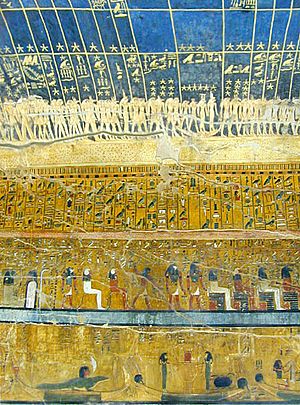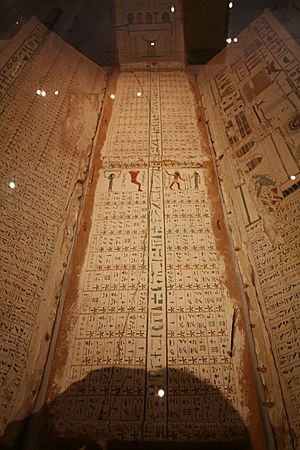Egyptian chronology facts for kids

Egyptian chronology is how experts figure out when things happened in ancient Egypt. It's like putting together a giant puzzle to place events and rulers on a timeline. Most Egyptologists (people who study ancient Egypt) agree on the main dates.
For example, the Old Kingdom started around 2700 BC. The Middle Kingdom began in the 21st century BC. And the New Kingdom started in the mid-16th century BC. But even with these agreements, some smaller details are still debated. Dates for the earliest times, like the Early Dynastic Period, can differ by up to 300 years! For the New Kingdom, dates might vary by about 30 years.
Contents
Understanding Ancient Egyptian Time
Historians and archaeologists work hard to create a timeline of ancient Egypt. This helps us understand how different kings and events fit together. Over the last 100 years, our understanding of this timeline has become much clearer.
For the earliest periods, like the Old Kingdom, dates have changed quite a bit. But for later periods, like the Middle and New Kingdoms, the dates have only shifted by a few decades. This is because new discoveries and better ways of studying old information help us get closer to the truth.
For example, early historians sometimes thought one ruling family (called a dynasty) ended before the next one began. Now, we know that sometimes different dynasties ruled at the same time in different parts of Egypt. This new understanding helps us make the timeline more accurate.
| Dynasty | Breasted (1906) | Shaw (2000) | |
|---|---|---|---|
| Early Dynastic Period | 1st | 3400–2980 | c. 3000–2686 |
| 2nd | |||
| Old Kingdom | 3rd | 2980–2900 | 2686–2613 |
| 4th | 2900–2750 | 2613–2494 | |
| 5th | 2750–2625 | 2494–2345 | |
| 6th | 2623–2475 | 2345–2181 | |
| First Intermediate Period | 7th | 2475–2445 | 2181–2160 |
| 8th | |||
| 9th | 2445–2160 | 2160–2025 | |
| 10th | |||
| Middle Kingdom of Egypt | 11th | 2160–2000 | 2125–1985 |
| 12th | 2000–1788 | 1985–1773 | |
| Second Intermediate Period | 13th? | 1780–1580 | 1773–1550 |
| 14th? | |||
| 15th | |||
| 16th | |||
| 17th | |||
| New Kingdom of Egypt | 18th | 1580–1350 | 1550–1295 |
| 19th | 1350–1205 | 1295–1186 | |
| 20th | 1200–1090 | 1186–1069 | |
| Third Intermediate Period | 21st | 1090–945 | 1069–945 |
| 22nd | 945–745 | 945–715 | |
| 23rd | 745–718 | 818–715 | |
| 24th | 718–712 | 727–715 | |
| 25th | 712–663 | 747–656 | |
| Late Period of ancient Egypt | 26th | 663–525 | 664–525 |
How Do We Date Ancient Egypt?
Historians use several methods to figure out the dates of ancient Egypt. It's like being a detective, looking for clues!
King Lists and Regnal Years

One main way is by using ancient Egyptian lists of kings. These lists often tell us how many years each king ruled. These are called regnal years. By adding them up, we can get a timeline.
However, these lists are not always perfect. Some, like the Turin King List, are very detailed but have missing pieces. Others, like the Abydos King List, are complete but don't list every single ruler. Also, different copies of the same text might have different information. For example, the ancient historian Manetho wrote a history of Egypt. His original work is lost, but later writers used it. Their versions often have different dates for the same rulers.
Sometimes, kings ruled at the same time in different parts of Egypt. This is called a coregency or overlapping dynasties. This can make it tricky to figure out the exact total years.
Egyptologists also look at other clues. For the Old Kingdom, they used to count "cattle censuses." These were regular counts of cattle. At first, they thought these happened every two years. But now we know they sometimes happened every year, or with longer gaps. Another clue is the sed festival. This special celebration was usually held after a pharaoh had ruled for 30 years.
Connecting to Other Events
To get very precise dates, experts look for links between Egyptian events and events in other ancient cultures. This is like finding a common point on two different timelines.
Archaeological Clues
Archaeology helps us put events in order. For example, stone pots from the first two dynasties were found under the Step Pyramid of Djoser. This pyramid was built during the Third Dynasty. This shows that the first two dynasties came before the third. Another example is stone blocks from the Old Kingdom that were later reused to build pyramids in the Middle Kingdom. This shows the Old Kingdom came before the Middle Kingdom.
Other Ancient Timelines
Timelines from other cultures, like Assyria and Babylonia, are very helpful. For instance, in the 18th century BC, a stone tablet from Byblos mentioned that Pharaoh Neferhotep I ruled at the same time as kings Zimri-Lim of Mari and Hammurabi of Babylon. During the Amarna Period (around 15th century BC), letters were sent between Egyptian kings like Amenhotep III and Akhenaten and rulers from other lands. These letters help line up the timelines.
Inscriptions and Records
Inscriptions on objects can give important clues. For example, the burial records of Apis bulls (sacred bulls) started during the reign of Amenhotep III. These records included details about the bulls and the rulers. By studying these, experts can estimate dates for different kings.
Astronomy Clues
Astronomy (the study of stars and planets) can also help. One famous method uses the Sothic cycle. This is based on the rising of the star Sirius. Some experts used this to set exact dates for the Twelfth Dynasty. However, new research sometimes changes how this information is used.
Radiocarbon Dating
Radiocarbon dating is a scientific method that measures how old something is. It's very useful for the Early Dynastic Period, where other dating methods can vary a lot. A study in 2013 used radiocarbon dating to suggest the First Dynasty started in the 32nd or 31st century BC. This fits well with other information.
Tree Rings (Dendrochronology)
Dendrochronology uses patterns in tree growth rings to find dates. This has been used for Egyptian chronology, especially for wood found in shipwrecks like the Uluburun shipwreck from the New Kingdom. By combining tree ring data with radiocarbon dating, experts can date wood samples from as far back as the Middle Kingdom. For example, a coffin from the Middle Kingdom was dated to 2073 BC using this method.
Related pages
Images for kids
-
Astronomical ceiling from the tomb of Seti I showing stars and constellations used in calendar calculations
See also
 In Spanish: Anexo:Cronología del Antiguo Egipto para niños
In Spanish: Anexo:Cronología del Antiguo Egipto para niños



